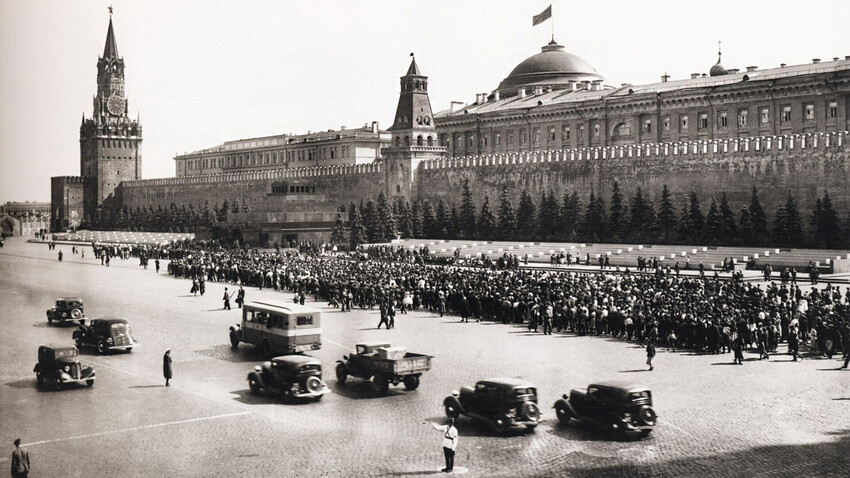
Through all the centuries of its existence, the Red Square, perhaps, hadn’t seen so many celebratory events. Holiday demonstrations were also held.
And military parades.
And mass marches of the trade unions of different fields and sport events.
And the meetings of communist women from all over the world.
The training of the Kremlin Regiment was sometimes also held there.
In 1924, after the death of Vladimir Lenin, a new attribute of the Soviet authority appeared on the Red Square that became iconic. First it was the temporary wooden, then permanent marble, Lenin Mausoleum.
However, rallies and meetings were not confined only to the Red Square; the propaganda work with the population was conducted throughout the city.
A ‘propaganda truck’ patrolling on Myasnitskaya Street.
A rally at Khodynka Field (symbolically, that’s where the coronation of Nicholas II was celebrated, when many people died in a crowd crush for free souvenirs).
One of the most famous photos of the leader of the revolution – Vladimir Lenin speaks from the tribune in front of the soldiers of the Red Army.
“Propaganda stations” were even created at train stations as centers of mass-political work. Below – the Kursky railway terminal.
Peasants arriving in Moscow for work.
For the people to digest political information in a more enjoyable way (and also for illiterate people), the Bolsheviks created propaganda brigades that acted out scenes (in the photo – the ‘Blue Blouse’ brigade acts in the ‘Red Army’ interlude).
There were also mobile film brigades that filmed and showed movies, a new art the Bolsheviks were betting on.
This is an ad for Sergei Eisenstein’s ‘Battleship Potemkin’ movie on the facade of the Khudozhestvenny cinema.
The new country required new art, so the Vkhutemas (Higher Art and Technical Studios) school was opened.
The Bolsheviks started actively shutting down churches and seizing church property. A lot of jewelry was sold to the West or re-melted for army needs. Below – soldiers take out valuables from the Simonov Monastery in the Moscow Kremlin, which would be later torn down.
A view of Strastnaya Square (on the right – the Passion Monastery, torn down later).
The old Cathedral of Christ the Saviour, torn down in the 1930s.
The fashion of the 1920s. Young girls of the New Economic Policy era stroll along the Chistoprudny Boulevard in the middle of Moscow.
The Sukharev Tower – a building that has vanished from the face of Moscow forever. It was torn down in 1934.
A tram stop on Sukharev Square.
You could still encounter a lot of horse-drawn carriages in the 1920s in Moscow. A lot of streets were narrow, but there were enough wide ones, as well, which hosted lively traffic of public and private transport. In the photo below, you can see the white Kitay-gorod wall, which would later be destroyed in the 1930s to widen the road and give more space for car traffic.
The ‘Red Moscow’ exhibition’ was organized in the 1920s in the building of the noblemen’s English Club; later, the whole Museum of the Revolution of the USSR was housed there.
The Bolsheviks were not just destroying, but building, as well. The Shukhov Broadcasting Tower is one of the symbols of the era, a true masterpiece. The photo below was taken by Alexander Rodchenko, the leading avant-garde photographer of the era. He found new unusual photo angles for new unusual buildings.
And below is how grand the All-Russian Agricultural and Industrial Crafts Exhibition looked, which took place in 1923 on Vorobyovy Gory (Sparrow Hills). Later, a special place was allocated for it and the huge VDNKh (Exhibition of Achievements of National Economy) park was built.
A mom and son inspect the stairwell of a new house on Usachev Street.
In 1925, a new building was erected in Moscow in the then-trendy Constructivist style. Advertisements in the avant-garde style were featured on the facade of the Mosselprom building; the text reads “Yeast”, “Cigarettes”, “Beer & Cold Drinks”, “Cookies”, “Candy”, “Chocolate” and “Nowhere, but at Mosselprom!”
Below is what a cigarette stand from Mosselprom looked like.
In 1929, a planetarium building in the Constructivist style was built.
Stalin being chauffeured in a car near the Bolshoi Theater in 1926.
Below is a bird’s eye view of the Theater Square from the Bolshoi Theater.
Swimming with a view of the Moscow Kremlin! Today, it’s hard to imagine someone taking a swim in the Moskva River in the center of the city.
A traditional Russian fun activity – winter sledding at Sparrow Hills.
And, finally, kids loved to be driven around by donkeys in Petrovsky park!
Dear readers,
Our website and social media accounts are under threat of being restricted or banned, due to the current circumstances. So, to keep up with our latest content, simply do the following:
If using any of Russia Beyond's content, partly or in full, always provide an active hyperlink to the original material.
Subscribe
to our newsletter!
Get the week's best stories straight to your inbox